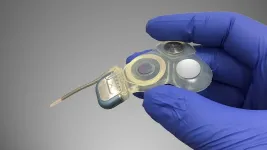(Press-News.org) Anti-retroviral drugs are a vital tool in the prevention and treatment of HIV. A new study of pregnant women in Tanzania shows that life-long antiviral treatment also seems to prevent viral transmission from mother to baby. The results of the study, which was conducted in part by researchers at Karolinska Institutet in Sweden and published in Lancet HIV, make a promising contribution to the WHO's work with HIV prevention in low and middle-income countries.
Just over eight years ago, the World Health Organisation (WHO) issued recommendations known as Option B+ for a simpler and more effective prevention and treatment for HIV during and beyond pregnancy in low and middle-income countries.
One arm of the Option B+ programme involved ensuring that pregnant women with HIV were started on a life-long regimen of antiviral drugs, ART, as early as possible during their pregnancy. Option B+ made an important breakthrough in the prevention of the mother-to-baby transmission of HIV.
Lifelong ART intervention can also provide effective protection against progression to more advanced HIV and early death, and prevent the further infection of partners and future children.
To date, however, research on how the treatment affects long-term viral levels in pregnant women with HIV in low and middle -income countries with a high HIV burden has been scant.
Now, researchers at Karolinska Institutet, Muhimbili University of Health and Allied Sciences and Management and Development for Health, have examined the effectiveness over time of Option B+ intervention in Tanzania.
According to UNAIDS figures from 2019, 4.8 percent of the Tanzanian population between the ages of 15 and 49, that is 1.7 million people, live with HIV.
The study, which was conducted in Dar es Salaam - Tanzania's largest city - included patient data for 10,161 pregnant women with HIV who had begun antiviral treatment on the Option B+ programme to prevent viral transmission to their unborn babies.
At the time of data collection, 5.9 per cent of the city's pregnant women starting antenatal care were HIV-positive. About a third of the study participants had advanced HIV disease.
The researchers measured the level of HIV in the women's blood to gauge the effectiveness of the antiviral treatment over time. The data was collected between 2014 and 2016, and the women were monitored for up to four years.
The results showed that up to 90 percent of the women under study had suppressed viral levels up to four years after starting Option B+ care. In other words, it seems possible that the WHO goal of eliminating transmission from mother to baby can be achieved.
"Our study confirms the lasting health benefits of life-long ART for women who go on Option B+ during pregnancy and therefore for their babies, too," says Goodluck Lyatuu, doctor and doctoral student at the Department of Global Public Health, Karolinska Institutet, and the study's first author. He continues:
"The results also point to some other important challenges when it comes to deriving the full long-term benefits of Option B+. To focus, for example, on some sub-groups of women, such as young mothers, mothers who start ante-natal care late during pregnancy and mothers with advanced HIV."
INFORMATION:
The study was financed by the Swedish International Development Cooperation Agency (Sida). There are no reported conflicts of interest.
Publication: "Long-term virological outcomes in women who started option B+ care during pregnancy for prevention of mother-to-child transmission of HIV in Dar es Salaam, Tanzania: a cohort study", Goodluck W Lyatuu, Shally Z Mwashemele, Roseline Urrio, Helga Naburi, Nassir Kashmir, Lameck Machumi, Ayoub Kibao, Ziada Sellah, Nzovu Ulenga, Nicola Orsini, Gunnel Biberfeld, Charles Kilewo, Anna Mia Ekstrom. Lancet HIV, online 11 February 2021, doi: 10.1016/ S2352-3018(20)30308-8.
Researchers from North Carolina State University used a three-model approach to trace the between-farm spread of porcine epidemic diarrhea virus (PEDV), as well as to analyze the efficacy of different control strategies in these scenarios. The approach may enable farmers to be more proactive in preventing the spread of PEDV and to optimize their efforts to control the disease.
PEDV is a virus that causes high mortality rates in preweaned piglets. The virus emerged in the U.S. in 2013 and by 2014 had infected approximately 50 percent of breeding herds. PEDV is transmitted by contact with contaminated fecal matter.
"We wanted to compare three different models by using actual outbreak data in order to test their efficacy," says Gustavo Machado, assistant professor of population ...
To build a universal quantum computer from fragile quantum components, effective implementation of quantum error correction (QEC) is an essential requirement and a central challenge. QEC is used in quantum computing, which has the potential to solve scientific problems beyond the scope of supercomputers, to protect quantum information from errors due to various noise.
Published by the journal Nature, research co-authored by University of Massachusetts Amherst physicist Chen Wang, graduate students Jeffrey Gertler and Shruti Shirol, and postdoctoral researcher Juliang Li takes a step toward building a fault-tolerant ...
New research from the Indiana University Kelley School of Business shows first evidence that watching and learning from others can help reduce bias and improve decision-making.
The research, published END ...
MUSC Hollings Cancer Center researcher Yongxia Wu, Ph.D., identified a new target molecule in the fight against graft-versus-host disease (GVHD). Bone marrow transplant, a treatment for certain blood cancers, is accompanied by potentially life-threatening GVHD in nearly 50% of patients. A January 2021 paper published in Cellular and Molecular Immunology revealed that activating a molecule called STING may be a new approach to reduce GVHD.
Xue-Zhong Yu, M.D., professor in the Department of Microbiology and Immunology, focuses on understanding the intricate immune mechanisms that regulate GVHD development and anti-tumor activity.
Recently, STING (stimulator of interferon genes) has been highly studied in the context of cancer. Data from other groups has shown that STING activation ...
Irvine, CA - February 11, 2021 - Subconsciously, our bodies keep time for us through an ancient means - the circadian clock. A new University of California, Irvine-led article reviews how the clock controls various aspects of homeostasis, and how organs coordinate their function over the course of a day.
"What is fascinating is that nearly every cell that makes up our organs has its own clock, and thus timing is a crucial aspect of biology," said Kevin B. Koronowski, PhD, lead author and a postdoctoral fellow in Biological Chemistry at the UCI School of Medicine. "Understanding how daily timing is integrated with function ...
A Russian physicist and his international colleagues studied a quantum point contact (QCP) between two conductors with external oscillating fields applied to the contact. They found that, for some types of contacts, an increase in the oscillation frequency above a critical value reduced the current to zero - a promising mechanism that can help create nanoelectronics components. This research supported by the Russian Science Foundation (RSF) was published in the Physical Review B journal.
A persistent trend in the modern electronics, miniaturization has spurred demand for new nano-sized devices that boast advanced performance and leverage quantum effects with electrons ...
Getting around without the need to concentrate on every step is something most of us can take for granted because our inner ears drive reflexes that make maintaining balance automatic. However, for about 1.8 million adults worldwide with bilateral vestibular hypofunction (BVH) -- loss of the inner ears' sense of balance -- walking requires constant attention to avoid a fall. Now, Johns Hopkins Medicine researchers have shown that they can facilitate walking, relieve dizziness and improve quality of life in patients with BVH by surgically implanting a stimulator that electrically ...
CORVALLIS, Ore. - The songs of fin whales can be used for seismic imaging of the oceanic crust, providing scientists a novel alternative to conventional surveying, a new study published this week in Science shows.
Fin whale songs contain signals that are reflected and refracted within the crust, including the sediment and the solid rock layers beneath. These signals, recorded on seismometers on the ocean bottom, can be used to determine the thickness of the layers as well as other information relevant to seismic research, said John Nabelek, a professor in Oregon State University's College of Earth, Ocean, and Atmospheric Sciences and a co-author of the paper.
"People in the past have used whale calls to track whales and study whale behavior. ...
For some 15,000 years, dogs have been our hunting partners, workmates, helpers and companions. Could they also be our next allies in the fight against COVID-19?
According to UC Santa Barbara professor emeritus Tommy Dickey(link is external) and his collaborator, BioScent researcher Heather Junqueira, they can. And with a review paper(link is external) published in the Journal of Osteopathic Medicine they have added to a small but growing consensus that trained medical scent dogs can effectively be used for screening individuals who may be infected with the COVID-19 virus.
This follows a comprehensive survey of research ...
DURHAM, N.C. - People who have a gene variant associated with an increased risk of developing Alzheimer's disease also tend to have changes in the fluid around their brain and spinal cord that are detectable years before symptoms arise, according to new research from Duke Health.
The work found that in people who carry the APOE4 gene variant, which is found in roughly 25 percent of the population, the cerebrospinal fluid contains lower levels of certain inflammatory molecules. This raises the possibility that these inflammatory molecules may be collecting in the brain where they may be damaging synapses, rather than floating freely in the cerebrospinal fluid.
The findings, which were published online last month in the Journal of Alzheimer's Disease, provide a potential ...






